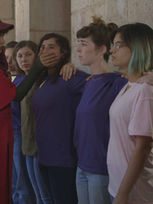EINAT AMIR
Basic Assumption 2017
Basic Assumption is a performance-psychological experiment hybrid, created by Einat Amir in collaboration with empathy researcher Yossi Hasson of the Emotion in Conflict Lab at the IDC Herzelia. The work explored critical questions about relationships between people and groups: Why is it so hard for us to feel empathy for those who are not like us and do not belong to our group? And is it possible to make people feel more empathy for others?
Before this experiment, we carried out some preliminary research among ultra-orthodox and secular people, and between Arabs and Jews. The studies showed that each group felt more empathy toward people from their group and less toward those from the other groups. The most interesting finding was that one of the things that prevents us from feeling empathy for somebody who is not from our group is the perception that empathy is a limited resource; many people relate to empathy as something that will run out if it is used too much.
The hypothesis of our performance / experiment was that if we tell people that empathy is not a limited resource and that it is, in fact, far more available to them than they think, they will extend empathy to more people, even if they are from other groups. The performance / experiment was divided into 24 sessions. Each session included approximately 40 audience members / participants.
The findings of this project are central for the research on empathy in the context of intergroup relations and in all aspects of our daily lives. Performing this research in Jerusalem provided a special opportunity to test our hypothesis in a city known for it’s diverse population that lives in constant tension and conflict; tension which makes empathy a crucial element in local everyday life.
In the first stage, each participant was randomly assigned to groups according to color, and was invited to go into one of four gazeboes. In each of the gazeboes there was a lecture performance given by a different actress. They provided information about empathy: the green, pink, and purple groups learned about identifying empathy through body language; the red group, which was at the heart of the experiment, learned about other things that I will discuss soon.
In the next stage, each member of the red group entered one of eight booths, while the other groups took their seats on the observation balcony. Two actors, one Jewish and one Arab, then went into the booths, one after the other. Each shared a personal story with the person opposite them about a family member’s medical problem or a difficult financial situation. The stories were based on truth but had been tailored to suit the experiment.
The main variable that we were examining was the level of empathy that the members of the red group felt toward the actors.
Empathy was measured in three performative ways: first, the red group members filled out questionnaires regarding the level of empathy they felt while listening to the actor standing opposite them; second, the actors provided data as to the level of empathy they felt had been directed toward them; third, the audience who observed the booths from the balcony and who analyzed the level of empathy displayed by the red group members by coding their body language provided their own data.
In the first stage of the experiment, we had explained to half of the red groups that empathy is an unlimited resource and that it is possible to feel it toward a large number of people. The other half of the red groups had not received this information and served as the control group.
The audience's involvement in this unusual event not only enabled us to examine our artistic and psychological hypotheses but also allowed us to evoke a discussion that in turn transformed the audience's traditional and cultural views. In the last stage of the performance / experiment, in order to equip our audience with a better understanding of the experience they had just been through, we showed them a video based on a debriefing script in which we reviewed and explained previous experiments regarding empathy research. The text in this video was performed by three dancers, in three different languages and was combined with choreography with defined visual language in costume and set design.
This experiment gathered real time quantitative data from the audience via the digital questionnaires they filled out throughout the experience. The results were then analyzed by us and shared with the audience via text message.
Results:
In this performance / experiment, we found that the belief that empathy is a limited or unlimited resource affects the degree of empathy that people feel toward members of another group. In addition, we found that empathy for members of the outgroup did not come at the expense of empathy towards the members of the ingroup. These findings are based on the self reports of the individuals in the cells, on the reports of the actors who felt the empathy shown to them, and also on the behavioral coding done by the audience on the balcony. These findings are of great significance for the study of empathy in the context of intergroup relationships, as well as in the daily lives of each and every one of us.









